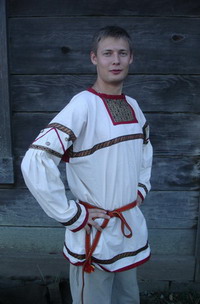
| Outfits >>> Replicas >>> Young bachelor's shirt | ||

|
| |
|
"Polyaki" of the Southern Altay region were descendants of Russian Old Believers (refuges who moved to Altay region in 1600's-1700's to protect themselves and their religion from government and state church oppression). A design of man's shirt is very ancient. Speaking of fashion and symbolysm of a clothes, Russian people were conservative in their tastes : "everything must be done as ancestors did". Village people thought about their clothes as "one more skin" (i.e. a part of their body). Because a body (and a life of a body) was thought as protected by spirits of the ancestors, so protectors would be able to distinguish their descendants from all other people easily. Costumes served that purpose. Depends on the period of time, costume fabrics varied significantly. So, this shirt looks like mid-1800's, because the trim is textile mill-made (not earlier than 1830-1840's). Golden colour of a trim is ethnographically correct: golden threads and trims were avaliable in Russian villages since 1400's (thanks to merchants travelled to India and Middle-East countries). The shirt is white, because people wore white color during any period of transformation of social role. The age of 15-25 years old for men is a period of transition from bachelority to married-man status. The bachelor's outfit was required to be rich and attractive - to show to neighbors (practical level of thinking) and spirits of the ancestors (spiritual/religious level) the wealthiness of a family, and the ability to feed one more branch of a family (new-married couple and their children). The whole bachelor's outfit consisted of 15-20 parts. It was very expencive to make them all at the same time. Only the richest families were able to do this. Mid-class families made (or decorated) that costume gradually. A decoration of this shirt points more likely to 20-year-old wearer than 15-year-old one. Bachelor's shirts didn't pass from father to son or from brother to brother. The reason was that a young man was required to be a member of "vataga" - a sort of a gang which was actually a remainder of military forces defended a village in the ancient time. Vatagas from different villages had to fight each other. Cutting and damaging of an opponent's clothing was an important part of a fighting (it was counted as a ritual insult). Speaking of a shirt's decoration: village people counted "the brighter, the better". They used a lot of buttons, bands, golden threads everywhere. A wrist/neck/bottom edges marked with red stripes ("fire" line) (it was a protection from evil spirits). A shoulder's seam was covered by a trim also (because a man works with arms, so arms have to be protected too). A chest part of bachelor's shirt was decorated with golden threads and bands (on a man's shirt they made an embroidery with solar designs). And you can count the trim line "chest-shoulder's seam-back-another shoulder's seam" as a circle - the most ancient protection symbol of Indo-European cultures.
| ||
Sources (in Russian)
| ||